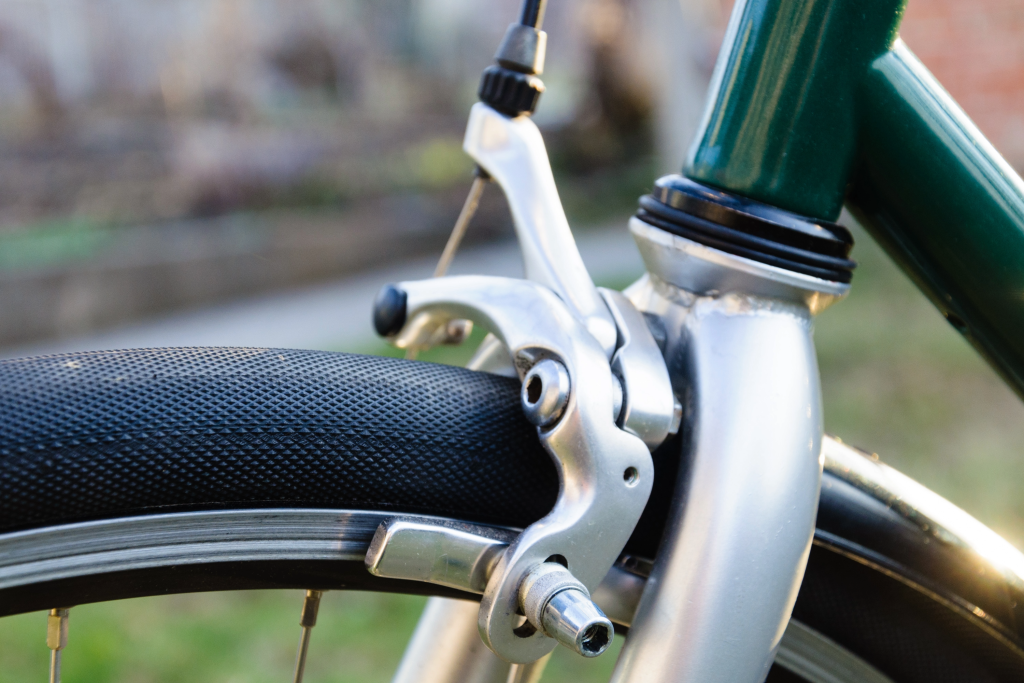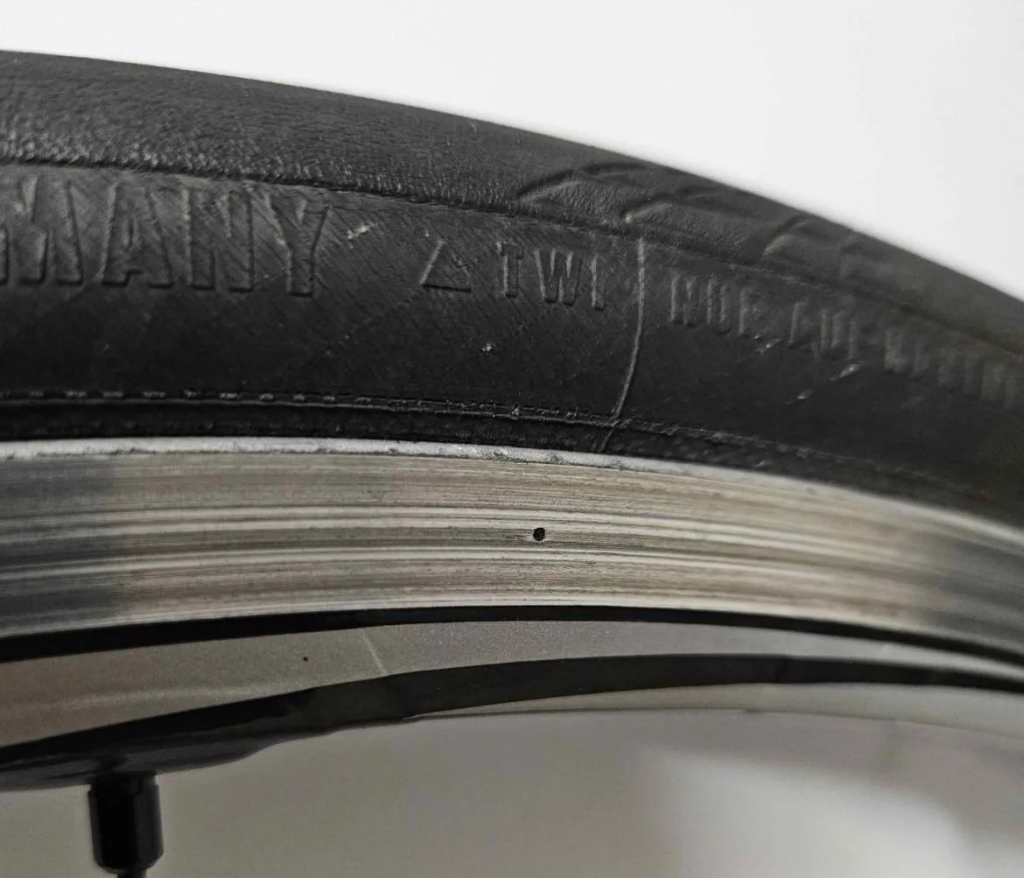Stay safe on your bike and learn the essential safety check every cyclist must do, check your rim brake wear indicators. These are an essential safety feature for cyclists using traditional rim brake systems. Although most of us have become accustomed to disc brakes on our bikes, some riders like me, still own traditional rim brake bikes and its important we stay safe on our bikes, essentially preventing life-threatening accidents.
These indicators help riders identify when their rims have worn down to an unsafe level, reducing the risk of sudden failures and accidents. Unlike disc brakes, which eliminate rim wear entirely, rim brakes require regular monitoring to ensure they remain safe for use. This article delves into the importance of rim brake wear indicators, how they function, and practical tips for maintaining your rims.
| Topic | Key Insights |
| What are rim brake wear indicators? | Visual or tactile markers on the rim sidewalls that signal when the rim is worn out. |
| Why are they important? | They prevent dangerous rim failures by alerting cyclists to replace worn rims. |
| How do they work? | Indicators disappear as the rim wears down, signalling the need for replacement. |
| Maintenance tips | Regularly inspect rims, replace brake pads, clean rims/pads, and maintain tyre pressure. |
| Disc brakes vs. rim brakes | Disc brakes avoid rim wear entirely, but rim brakes remain popular for simplicity and cost-effectiveness. |
The Role of Rim Brake Wear Indicators

Staying safe on your bike is essential and checking the rim brake wear indicators that are built into the sidewalls of bicycle rims, provide a clear signal of wear over time. As braking friction gradually thins the rim’s sidewalls, these indicators help cyclists determine when it’s time to replace the rim. Without them, it can be challenging to visually assess the condition of a worn rim.
Braking causes wear this is a fact you cannot avoid. With disc brakes, it’s relatively inexpensive and easy to replace the rotors, but with rim brakes, it’s the sidewalls of your rims. That might not matter if you’re running low-cost wheels and you don’t ride big miles, but it can get frustrating if you’ve just invested a lot of money in a set expensive wheels.
Why Rim Brake Wear Indicators Are Important
These indicators are crucial for maintaining safety when using traditional braking systems. Without them, gradual wear might go unnoticed until a failure occurs—potentially leading to hazardous situations during high-speed rides.
While modern disc brakes eliminate the issue of rim wear by using separate rotors for braking surfaces, many cyclists still prefer rim brakes due to their simplicity, affordability, and compatibility with certain bike designs. For these riders, monitoring rim wear is essential.
How Rim Brake Wear Indicators Work

Rim brake wear indicators are designed to be easily identifiable. They typically appear as grooves, channels, or small dots on the braking surface of the rim. As you use your brakes over time, these markers gradually wear away along with the rim material. When these indicators disappear or become difficult to see, it signals that the rim has reached its wear limit and should be replaced.
By paying attention to these markers, cyclists can ensure timely replacement of rims and avoid dangerous situations caused by excessive thinning.
If your rims become too worn then braking performance is going to be compromised, which in extreme cases, you run the risk of the wheel failing entirely because there isn’t enough material in the rim wall to cope with the forces exerted upon the rim by the high-pressure tyre.
How long you can expect a rim to last?
It’s difficult to say because it depends on the force of your braking and how clean you keep your pads and your rim. If you can avoid excessively dragging the brakes and if you clean your bike regularly, paying particular attention to the braking track on the wheels and the face of the brake pad you’ll significantly extend the life of your wheels.
Tips for Maintaining Rims and Brake Systems
To extend the lifespan of your rims and ensure safe cycling:
- Inspect wear indicators regularly: Check your rims frequently to monitor their condition.
- Replace brake pads as needed: Worn pads can increase abrasion on your rims.
- Clean rims and pads often: Dirt and debris can accelerate wear on braking surfaces.
- Maintain proper tyre pressure: Overinflated or underinflated tyres can stress rims unnecessarily.
By incorporating these practices into your routine, you can prevent unexpected failures and enjoy safer rides.
Frequently Asked Questions (FAQs)
1. What happens if I ignore rim brake wear indicators?
Ignoring these indicators can lead to catastrophic rim failure during rides, especially at high speeds. This could result in accidents or injuries as the braking surface becomes too thin to function properly.
2. How can I identify rim brake wear indicators on my bike?
Look for grooves, channels, or dots on the braking surface of your bike’s rims. These features are designed to be easily visible and will disappear as the rim wears down.
3. How often should I check my rim brake wear indicators?
It’s recommended to inspect your rims every few weeks if you ride regularly or before embarking on long-distance rides. Regular checks ensure you catch wear early and replace rims before they become unsafe.
4. Can I repair a worn-out rim instead of replacing it?
No, once a rim reaches its wear limit, it must be replaced entirely. Repairing a worn-out rim is not safe or practical because its structural integrity has been compromised.
5. Are disc brakes safer than rim brakes?
Disc brakes eliminate the issue of rim wear entirely and provide consistent braking performance in all conditions, making them a safer option in terms of maintenance concerns. However, many cyclists still prefer rim brakes for their simplicity and affordability.
6. How can I prolong the life of my rims?
To extend your rims’ lifespan:
- Replace brake pads regularly to avoid excessive abrasion.
- Clean rims and pads frequently to remove debris that accelerates wear.
- Maintain proper tyre pressure to reduce stress on the rims during rides.
7. What should I do if I suspect my rims are worn but the indicators are still visible?
If you suspect excessive wear despite visible indicators, consult a professional bike mechanic for an inspection. They can assess whether your rims are safe to use or require replacement.
Rim brake wear indicators may seem like a small feature but play an outsized role in cyclist safety. By regularly inspecting these markers and maintaining your braking system properly, you can avoid dangerous failures while extending your equipment’s lifespan. Whether you’re an avid cyclist or someone who enjoys occasional rides, paying attention to these details ensures reliable performance and peace of mind on every journey!

Leave a Reply